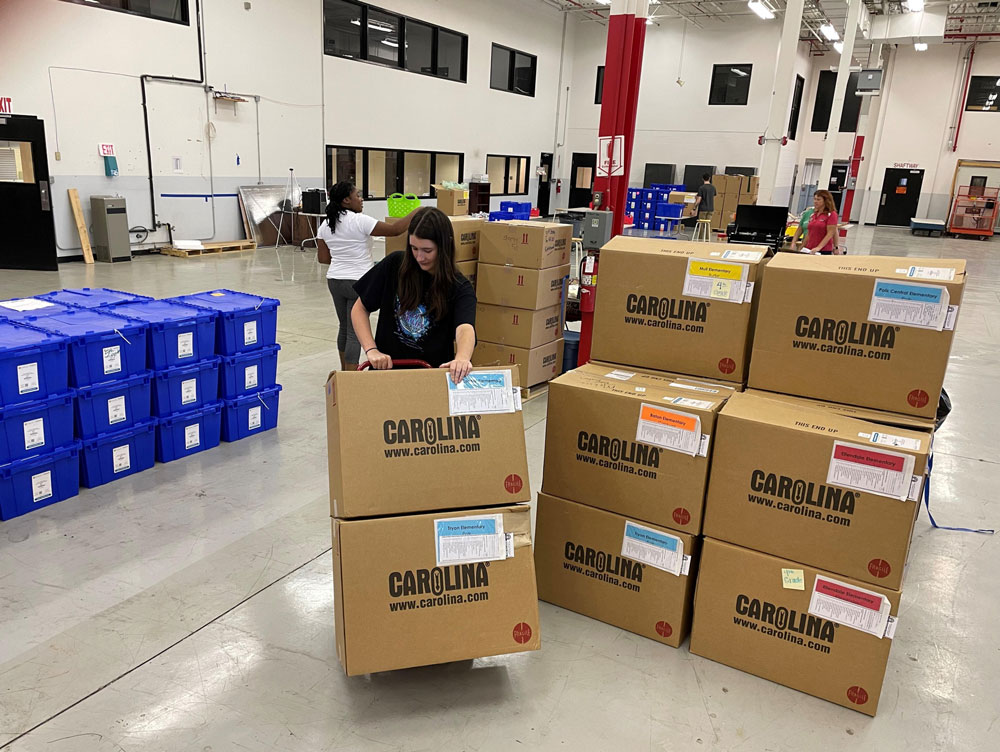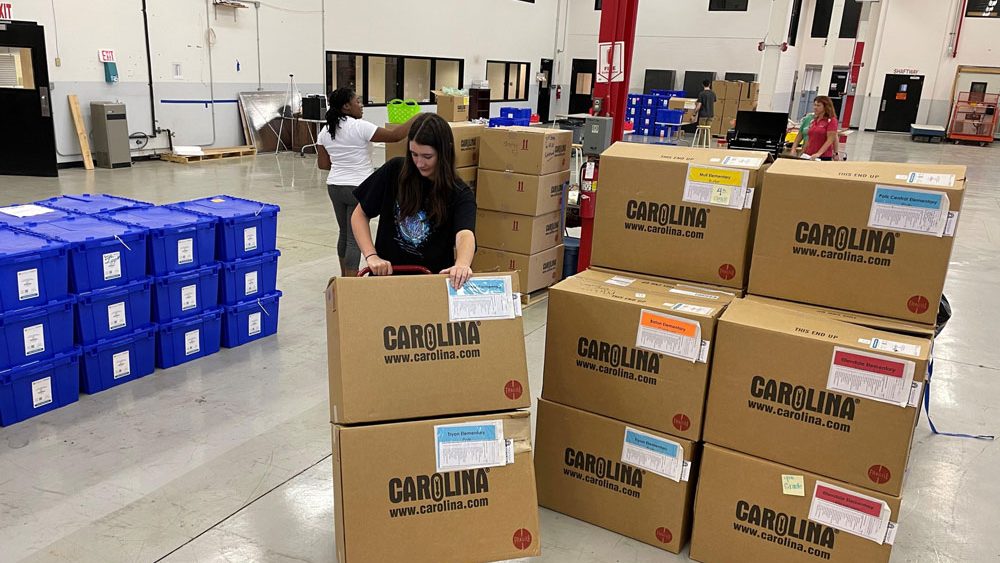
Prepping Smithsonian Science Education Center materials for delivery to teachers in Alexander, Burke, Caldwell, and Polk school districts.
An exciting force is sweeping across Western North Carolina schools and it’s transforming all teachers into science teachers and students who never embraced STEM subject matter before into investigators, explorers, and scientists who love getting their hands dirty!
The Smithsonian Science Education Center (SSEC) and the NC SMT Center are partners with Alexander, Burke, Caldwell, and Polk school districts in North Carolina, elevating science and inquiry instruction. Now in its third year of a five-year grant funded by the U.S. Department of Education, the partnership provides not only hands-on curriculum materials for 3rd through 5th grade students to explore but professional development and support to teachers.
Among the most full-throated supporters of the SSEC curriculum are Dr. Sam Houston, President and CEO of the NC Science, Mathematics, and Technology Education Center, and Mr. Aaron Greene, former teacher and current Superintendent of Polk County Schools (one of the school districts participating in the study).
“Engaged learners are easier to work with,” notes Dr. Houston, and these kits developed by SSEC ensure that the days of rote learning are over, replaced with hands-on activities that pull students in, encourage inquiry, and make school fun. With a research-based curriculum as the foundation, teachers are supported through professional development to stop just answering questions, but rather to drive students to craft a better question, develop hypotheses, and test their theories and uncover answers on their own. As Dr. Houston often says, “The goal is to teach students what to do when they don’t know what to do” — not just hand over the answer without a fight!
Students Shine
So, how are students performing? While formal testing has been challenged by COVID and the virtual learning that followed, Greene notes that science scores have remained steady, and, more importantly, students and teachers are more engaged than ever. In fact, students who had never shown an aptitude or enthusiasm for science before are shining now.
“These exceptionally well-researched and supported materials give teachers a better opportunity to highlight the skills and abilities that some kids have that may not translate to a paper and pencil test,” says Greene. “I have lots of kids who don’t do well on standardized tests who really excel in hands-on activities. THIS gives those kids a place to stand and the confidence they need to springboard into something they’re interested in.”
Dr. Houston echoes this sentiment, pointing to kids who don’t see themselves as “STEM kids” who suddenly find something special and engaging in the sleeves-rolled-up science investigations. Suddenly, these students are indistinguishable from the “high flyers” as Houston says the curriculum serves as a “leveling of the playing field where we learn all sorts of things observing their work that we wouldn’t learn using traditional materials.”
And students learn things about themselves they might not learn with a standard curriculum. This course opens up a whole new world, shining a light on careers and fields many elementary school students have never heard of. As Greene says, we’re so concerned with making sure kids are proficient in reading and math, “We fail to focus on the HOPE aspect. Now we see kids asking ‘Can I see myself doing this for a living? What do I need to learn to get there?’” The program actually drives kids to think about what they want to do with their lives and challenges them to do it.
Parents and Teachers Embrace the Program
Often, when a major shake-up in teaching methodology or expectations is implemented, there can be substantial push-back from both teachers and parents. Both Houston and Greene agree that the opposite has happened in the schools using the SCC materials.
“We’re changing the way teachers think about what they do every day and hopefully in a positive, comfortable way,” says Houston. “They are being supported through materials and professional development to focus on science, but also to use scientific principles to encourage students to ask great questions, dig deep, get dirty, and challenge themselves—in language and math as well as science.” Teachers are actually using science as a tool to teach math, language, and even the arts.
“Teachers don’t feel like they’re wasting their time on fluff,” adds Greene. “You get that happy marriage of sharing the content and skills with the kids in a way that’s fun, that teaches them critical thinking skills, and helps them attack problems using the scientific method. It pays huge dividends and kids are more receptive to future studies. That engagement makes for happy teachers.”
According to Greene, parents are thrilled with the new teaching style as well. Kids are coming home with hands-on homework they can’t wait to get started on. Diagrams and memorization are replaced with engaging investigations, puzzles, and projects that challenge kids to ask good questions, investigate on their own, and think critically. All skills they can apply to every subject on their schedule, not to mention their daily lives outside of school.
Charting a New Path
Within the year, the data collection portion of the SSEC grant will conclude, and the Center for Research and Education Policy at the University of Memphis will begin analyzing the data. Teachers in the four participating counties will continue to use the curriculum, and others may take it up too. Dr. Houston and Superintendent Greene have both expressed their hopes for the continued use of the program in North Carolina.
“I hope this process leads to a shift in our way of thinking about STEM and science instruction in general. I’d love to see that shift to our whole educational model to more of a problem-based application based, hands on environment,” says Greene. Pointing to the current practice of testing, testing, testing, he says, “I hope we figure out that this ‘drill and kill’ method is necessary to some degree but at the end of the day, what inspires kids and gets them to make connections in their brain is to have to extend, to be hands-on, to talk about things without clear-cut answers.”
Dr. Houston’s hopes reach further into the future, anticipating how graduates of this program will thrive in the workplace of the coming decades. He notes that we don’t even know what the workplace of the future will look like, but that it’s going to change very rapidly. “But, what is clear,” continues Houston, “is we need to give kids flexible skills they can use to adapt to the unknowns they will be confronted with; to give them the ability to take what they know (skills, experience, and information) and adapt it to an ever-changing environment.”
The Smithsonian Science Center has created something very special in its science-based curriculum, but Dr. Houston emphasizes that this program isn’t simply designed to just teach STEM. “Our big hope,” he concludes, “is that schools will be transformed through this program to focus on research, on inquiry. To adapt to the changing needs of the learner and to provide them with the tools and the inquisitive spirit to excel in whatever subjects and careers their future holds.”
Dr. Sam Houston is the President and CEO of the NC Science, Mathematics, and Technology Education Center. He has served as superintendent of schools (including for ten years over the Mooresville Graded School District when it opened the state’s first year-round school) and is the namesake of the Leadership Award for the NC School Superintendent’s Association yearly honor.
Superintendent Aaron Greene begins his 27th year in education this school year, six as superintendent. He obtained his Teaching degree and Masters degree from North Carolina universities and has dedicated his career to serving in both educational and administrative roles in Polk County schools.
For additional information about the Smithsonian Science Education Center and this unique curriculum, click here.

Comments are closed.